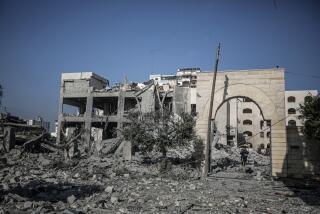Conservation Key to Pompeii’s Self-Preservation
- Share via
POMPEII, Italy — The longest lines start at the ancient brothel, where tourists ogle the erotic frescoes and terra-cotta sculptures.
Up and down Pompeii’s stone streets, hordes of visitors crowd around the restored ruins of elegant villas, examine the chipped remains of fading mosaics, and plod through the city that nearly 2,000 years ago met its death under a deluge of volcanic ash, lava and poisonous gas.
Just a few years ago, the ancient metropolis risked extinction again -- crushed this time not by the majestic Mt. Vesuvius but by the trample of tourists and the ravages of rain, unusual heat and other elements.
Today, Pompeii, a pillar in Italy’s tourism-based economy, is by no means out of the woods. But there are promising signs of recovery, according to archeological experts and what meets the eye.
One key change involves an experiment in a form of self-government, a radical departure from Italy’s tradition of state custodianship. After the appointment of an energetic and respected superintendent for all Pompeii-area archeological sites, Pietro Giovanni Guzzo, Italian authorities in late 1997 agreed to allow all ticket and tourism-related revenue to stay in Pompeii’s budget. Also, Guzzo was given permission to seek private investment.
Guzzo says Pompeii takes in about $23 million, and the European Union has contributed about $34 million for a five-year program. That’s in addition to several restoration projects being sponsored by international foundations.
“We have much more money than before,” Guzzo said, adding quickly, “but it’s always too little.”
Guzzo shifted the focus of Pompeii to preserving what has been discovered rather than seeking to unearth other parts of the vast, 163-acre site. The policy is not without its detractors in the highly political world of archeological scholarship. But he sees as folly the urge to expose additional wonders when those accessible are decaying.
“Pompeii is an ancient city that died,” Guzzo said at his nondescript office on the edge of the site, where only one, careful excavation by Swedes was in progress during a recent visit. “We are not trying to make new life here. That is impossible. We can only conserve what’s there. And work to make the public understand.”
Conditions had deteriorated so badly by the mid-1990s that only 14% of the excavated site was open to the public; today, open areas are twice that, Guzzo said. Still, that’s only about 25 villas. Forty years ago, visitors had access to 64 of them.
Roping off houses and rotating visits to those that are accessible may not please the tourists, but it does ward off some of the damage, Pompeii’s administrators argue. And if this kind of managed tourism works in Pompeii, it could serve as a model for other sites in Italy.
In 1996, the New York-based World Monuments Fund declared Pompeii one of the world’s most endangered sites, and UNESCO followed suit by putting Pompeii on its World Heritage List in 1998.
The World Monuments Fund is sponsoring an international symposium this month in Naples to assess progress at Pompeii.
The Vesuvius volcano erupted on an August afternoon in AD 79, spewing fiery ash and stones onto Pompeii, a seaside summer resort and playground for the elite, and surrounding villages. Many fled, but thousands were killed as the valley was buried under 20 feet of powdery and molten destruction. The result was a near-perfect picture, frozen in time, of imperial Rome.
Pompeii was rediscovered in 1748, when systematic excavations began and explorers frequently made off with treasures. Priceless frescoes and mosaic tile floors were exposed to haphazard digs and uncontrolled tourism with no protection from the elements. What the ash of Vesuvius had preserved for nearly 17 centuries was steadily battered, neglected, vandalized or destroyed.
Fully one-third of what was the ancient city of Pompeii has not been excavated and remains covered in brush, dirt and stones.
The debate today, both at Pompeii and other sites buried by Vesuvius, as well as throughout the archeological world, is whether to dig or preserve. Guzzo sides with preserving.
Pompeii is plagued with endless troubles, erosion, collapsing walls and fading art, and any progress is fragile. When he isn’t grappling with the local Neapolitan mafia or his own agency’s deeply entrenched bureaucracy, Guzzo has sought corporate sponsorships for restoration projects, but without much luck.
According to the Italian Culture Ministry, nearly 2.2 million people visited Pompeii in 2001, more than twice the number two decades earlier, when much more of the site was open to the public. The total dropped to less than 1.6 million last year, part of an overall decline in tourism to Europe in the wake of the Sept. 11 attacks.
The 150 or so guards at the site are, apparently, still not enough. Just last month, thieves broke into Pompeii at night and made off with a 66-pound piece of marble from a fountain in the House of the Ceii.
It was the second major theft in six months. Two detailed frescoes stolen in April were, however, recovered.
Andrew Wallace-Hadrill, director of the British School at Rome and an expert on the Pompeii area, praised the efforts here but said it might be a losing battle. As fast as stucco is repaired in the corner of one villa, it falls in another. And he said support from the Italian government might be fleeting, pointing out that authorities in Rome had not always appreciated the importance of cultural heritage to the national economy.
“Pompeii is a household name, and the Italian authorities have to believe in it,” Wallace-Hadrill said. “It could crumble away in our lifetime.”
Wilkinson was recently on assignment in Pompeii.
More to Read
Sign up for The Wild
We’ll help you find the best places to hike, bike and run, as well as the perfect silent spots for meditation and yoga.
You may occasionally receive promotional content from the Los Angeles Times.







